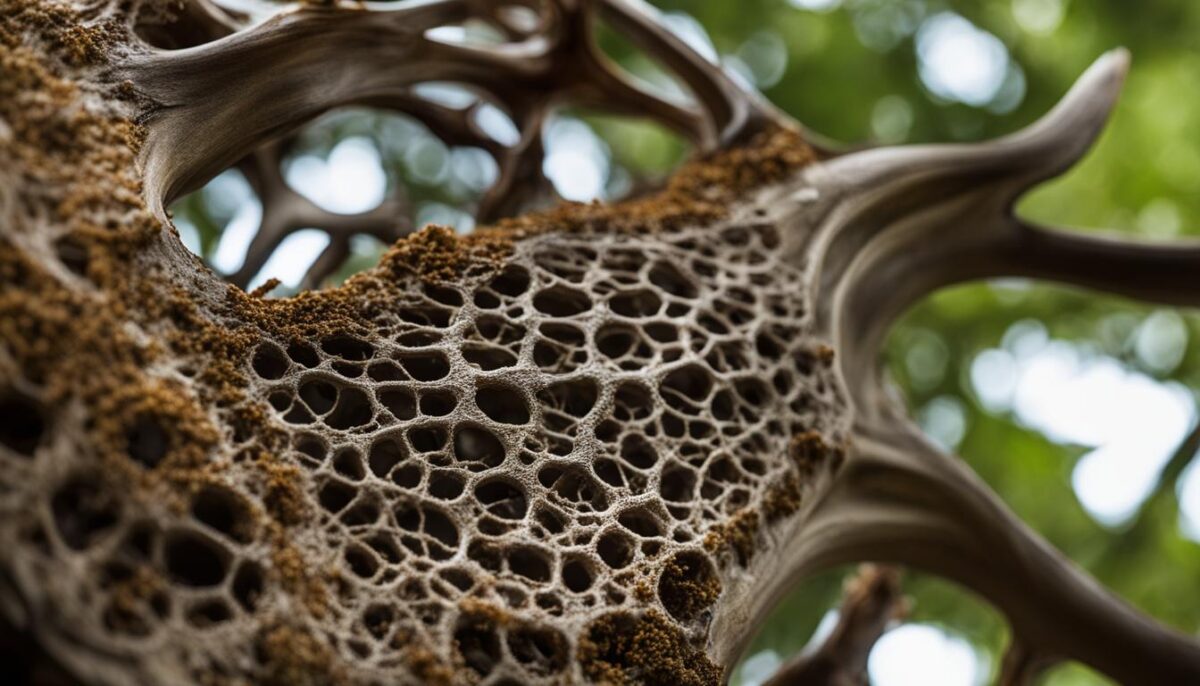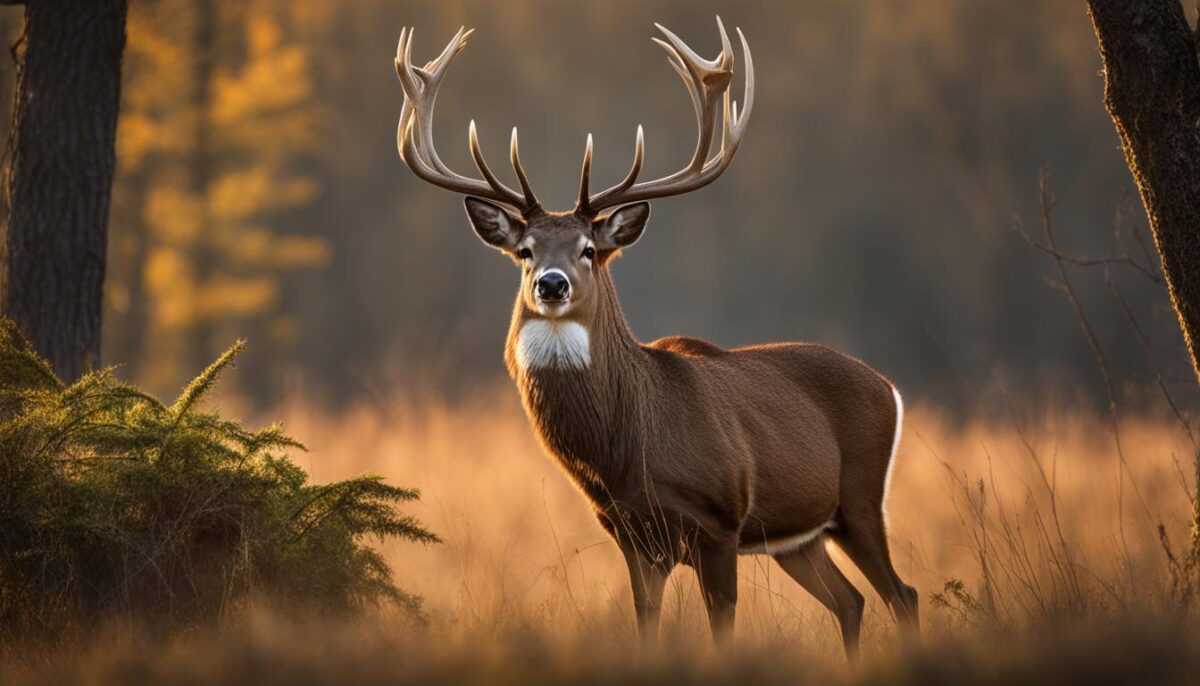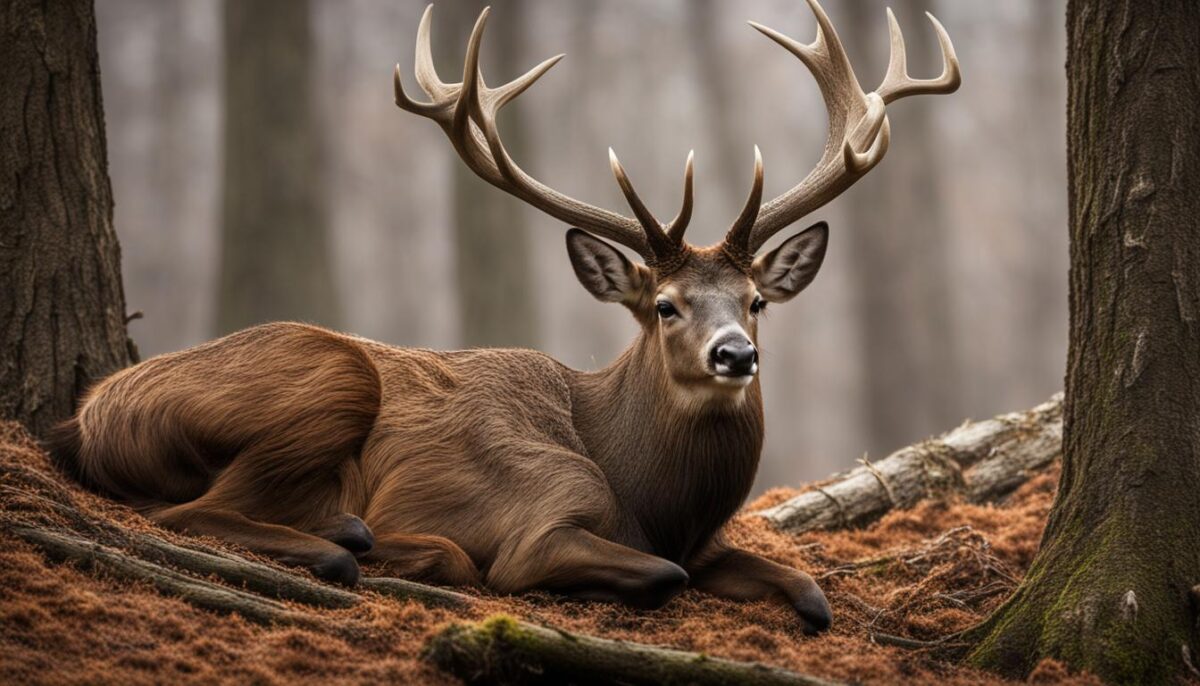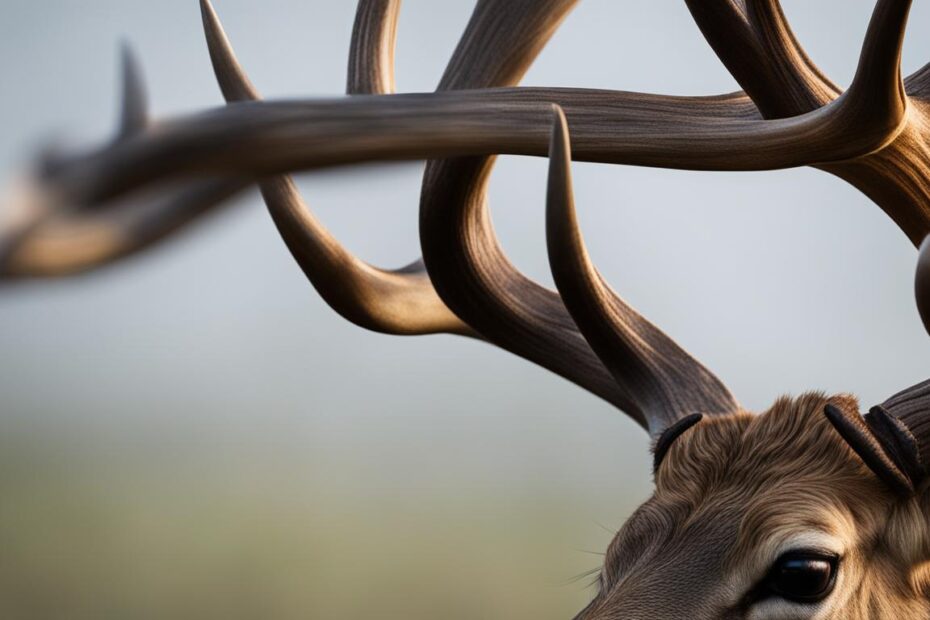Have you ever wondered what those bumps on deer antlers are? In this article, we will explore the fascinating world of deer antlers and uncover the truth behind those mysterious bumps.
Deer antlers are composed primarily of calcium and phosphorus and are shed and grown anew each year. But those small hair-covered bumps on a young deer’s head are not the antlers themselves. They are actually called pedicels and serve as the base from which antlers grow.
The antler growth cycle is influenced by day length, with growth typically beginning in April. During the growth period, antlers can grow at a remarkable rate of ¼ inch per day and are covered with velvet, which provides nourishment. By late summer, the velvet dries up and falls off, leaving behind fully mineralized and hardened antlers.
Key Takeaways:
- The bumps on a young deer’s head are called pedicels, not antlers.
- Antlers are shed and grown anew each year.
- Antler growth is controlled by day length and is influenced by the reproductive hormone testosterone.
- Antlers serve various purposes, including dominance establishment and mate attraction.
- The growth process of antlers involves the stimulation of antler growth by the tissue at the top of the pedicels.
The Difference Between Antlers and Horns
Antlers and horns are often confused, but there are key differences between them. Antlers are true bone, while horns are made of keratin, a hair-like tissue that grows over a bony core. Unlike horns, antlers are shed and grown anew each year. Antlers grow from pedicels on the frontal bone of the skull, while horns are present year-round. Antlers are typically covered in velvet during growth, which provides nourishment, and the velvet is shed in late summer. Horns, on the other hand, are not shed and continue to grow throughout an animal’s lifetime.
“Antlers are true bone, while horns are made of keratin, a hair-like tissue that grows over a bony core.”
Antlers
- True bone
- Shed and regrown annually
- Grow from pedicels on the frontal bone of the skull
- Covered in velvet during growth
- Used for dominance and attracting mates
Horns
- Made of keratin
- Present year-round
- Continuously grow throughout an animal’s lifetime
- Not covered in velvet
- Used for defense and territorial displays
Understanding the difference between antlers and horns is crucial for properly identifying and appreciating these unique features of deer and other animals. While both antlers and horns are impressive adaptations, their structure, growth patterns, and purposes are distinct. So, the next time you come across a deer with impressive headgear, you’ll know whether it’s sporting antlers or horns!
The Purpose of Antler Growth
Antler growth serves various important purposes in the life of a deer. It is ultimately controlled by the reproductive hormone testosterone, which is regulated by the photoperiod or day length. As the days get shorter, testosterone levels increase, triggering the growth of antlers. This growth cycle typically begins in April and continues until late summer when the antlers harden and the velvet covering dries up and falls off.
The primary purpose of antler growth is for dominance and mate attraction during the breeding season. Bucks use their antlers to spar with other males and establish their rank in the hierarchy. The size and strength of their antlers play a significant role in determining their dominance and reproductive success. Additionally, antlers also serve as a means of thermoregulation during hot weather. The large surface area of the antlers helps dissipate heat and cool the deer’s body.
Overall, antler growth is a fascinating and important process that allows deer to assert dominance, attract mates, and adapt to their environment. It is a complex interplay between hormones, day length, and genetic factors that ultimately shape the magnificent antlers we associate with these majestic animals.

The Role of Testosterone and Photoperiod
“The growth of antlers is ultimately controlled by the reproductive hormone testosterone, which is regulated by the photoperiod, or day length. Testosterone levels increase as day length decreases, triggering antler growth.” – Wildlife Biologist
Antler Growth for Dominance and Mate Attraction
“Antlers serve as a means for bucks to establish dominance and attract mates during the breeding season. Bucks spar with other males using their antlers to determine hierarchy and reproductive success.” – Wildlife Biologist
Antlers for Thermoregulation
“Antlers also play a role in thermoregulation, helping deer cool their bodies during hot weather. The large surface area of the antlers helps dissipate heat and maintain a comfortable body temperature.” – Wildlife Biologist
The Growth Process of Antlers
The growth of antlers begins with the pedicels, small bumps located on the frontal bone of a deer’s skull. These pedicels serve as the base for antler growth. The skin or tissue at the top of the pedicels reacts to hormonal signals in the deer’s body and stimulates the growth of antlers. This growth process typically starts in April and can reach a rate of ¼ inch per day. During this period, antlers are covered in velvet, a soft and vascularized skin that provides nourishment and support for the growing antlers.
The velvet is rich in blood vessels and nerves, ensuring that the antlers receive the necessary nutrients for growth. As the antlers near maturity, usually by late summer, the blood vessels within the antlers begin to fill up. At this stage, the velvet dries up and falls off, revealing the fully mineralized and hard antlers underneath. The mineralization process gives the antlers their strength and durability, making them ready for various purposes such as sparring, establishing dominance, and attracting mates during the breeding season.
In summary, the growth of antlers follows a complex and fascinating process. It starts with the development of pedicels, followed by the hormonal stimulation of antler growth. Velvet covers the growing antlers, providing nourishment and support. As the antlers mature, the velvet dries up and falls off, revealing the mineralized and fully formed antlers. This growth process is vital for deer, as antlers play crucial roles in behaviors such as territorial dominance and reproductive success.
The Cycle of Antler Growth and Shedding
Understanding the cycle of antler growth and shedding is essential for comprehending the fascinating life cycle of deer. Antler growth typically begins in April and progresses rapidly, reaching full development within approximately four months. During this period, antlers can grow at an impressive rate of up to a quarter of an inch per day. As the days grow shorter in late summer, a surge in testosterone levels triggers the hardening of antlers, marking the end of the growth phase.
Following the growth phase, antlers play a crucial role during the breeding season. Bucks utilize their antlers to establish dominance and attract mates. After the breeding season concludes, an abscission zone forms at the junction of the pedicel and antler. This zone facilitates the shedding process, allowing the antler to detach from the deer’s skull. Shed antlers, which can provide valuable insights into deer behavior and population dynamics, are typically found in January and/or February.
To visualize the cycle of antler growth and shedding, refer to the table below:
| Phase | Description |
|---|---|
| April – August | Antler Growth |
| Late Summer | Hardening of Antlers |
| Breeding Season | Utilization of Antlers for Dominance and Mating |
| January – February | Shedding of Antlers |
By understanding the cycle of antler growth and shedding, wildlife enthusiasts and hunters alike can gain a deeper appreciation for the remarkable natural processes that govern the lives of deer.
Factors Affecting Antler Size
Several factors contribute to the size of deer antlers, including age, nutrition, and genetics. Understanding these factors can provide insights into the development and potential of antlers in different deer populations.
Age: As bucks mature, their antlers tend to grow larger. Younger bucks typically have smaller antlers, while older bucks have had more time to develop larger and more impressive antlers. Age is the simplest factor to understand when it comes to antler size.
Nutrition: Adequate nutrition is essential for antler growth. Bucks need access to a balanced and nutritious diet to support the development and size of their antlers. Areas with abundant food resources can result in bucks with larger antlers, while areas with limited food availability may produce smaller antlers.
Genetics: Genetics also play a role in determining antler size. Certain bloodlines may have a genetic predisposition for larger antlers, while others may have smaller antlers. However, managing genetics in free-ranging deer herds can be challenging, as it is difficult to control or manipulate the breeding patterns of wild deer.

In summary, antler size is influenced by age, nutrition, and genetics. While age and nutrition are factors that can be managed and influenced to some extent, genetics are inherent and more challenging to control. Understanding these factors can provide valuable insights into the variations in antler size among deer populations and contribute to effective management strategies.
Unique Antler Facts
While antlers have many fascinating aspects, there are a few unique facts that set them apart. One intriguing phenomenon is the connection between injury and antler development. If a buck sustains a serious injury to one of its hind legs, it can impact the growth and development of the antler on the opposite side. This can result in an abnormal and stunted antler, even after the leg has healed.
“An injury to a buck’s back leg can affect the antler development on the opposite side.”
Another interesting antler fact is the existence of “cactus bucks.” These are bucks that have low testosterone production, causing them to never shed their antlers. Instead, they continue to grow new velvet and antler material over the existing antlers each year. This unique condition creates a distinctive look among these bucks and provides an intriguing area of study for researchers.
With their connection to injury and their ability to retain antlers, deer continue to surprise us with their fascinating antler facts. These unique aspects contribute to the overall beauty and intrigue of these remarkable structures.
Understanding Antler Casting
Antler casting, also known as shedding, is an intriguing phenomenon that provides valuable insights into deer behavior and patterns. By utilizing trail cameras, hunters and wildlife enthusiasts can closely monitor the timing and locations of antler casting, enabling them to track the movements of bucks. This information can be crucial for planning hunting strategies and gaining a better understanding of deer behavior.
One of the benefits of studying antler casting is the ability to identify specific antler patterns. Bucks tend to shed their antlers at consistent times and in familiar areas each year. By comparing information on cast antlers with neighboring properties, researchers can gather valuable data on buck movements throughout different seasons. This allows them to make informed decisions about habitat management and conservation efforts.
Furthermore, antler casting can offer valuable insights into deer behavior. The shedding of antlers often coincides with other important events in a deer’s life, such as the breeding season. By observing patterns in antler casting, researchers can gain a better understanding of the timing and duration of the rut, as well as the behaviors associated with it. This information can be useful for wildlife management and population control strategies.
| Benefits of Studying Antler Casting | Insights Gained |
|---|---|
| Track buck movements | Identify migration patterns and preferred habitats |
| Plan hunting strategies | Target specific areas and times when bucks are more vulnerable |
| Understand deer behavior | Gain insights into rut timing, breeding behaviors, and population dynamics |
| Inform habitat management | Make data-driven decisions for conservation and wildlife management efforts |
Overall, antler casting is a fascinating phenomenon that provides valuable information about deer behavior, movement patterns, and population dynamics. By utilizing trail cameras and analyzing cast antlers, researchers and wildlife enthusiasts can gain insights that contribute to effective wildlife management strategies and enhance our understanding of these majestic creatures.

What Cast Antlers Can Tell Us
Cast antlers can provide valuable insights into various aspects of deer populations. While they may not accurately depict the age of a buck based on the profile of the antler attachment, there are other indicators that can help determine age. Basal circumference and beam length, for example, tend to increase with age and can be used as age indicators when analyzing cast antlers. These measurements allow for a rough estimation of a buck’s maturity and can provide valuable information about the age structure of a deer population.
Additionally, studying cast antlers can provide clues about the nutritional plane of a deer herd. The presence and prominence of “pearls” on the antler base indicate good nutrition, as these pearls are formed by the deposition of minerals during antler growth. In contrast, the absence or faint presence of pearls may suggest nutritional deficiencies or challenges within the habitat. By analyzing cast antlers for these clues, wildlife managers can gain insights into the overall health and productivity of the deer population in a particular area.
Comparing antlers from different areas can also help identify the origins of bucks and their movement patterns. Each deer population may have unique characteristics in terms of antler size and shape, and comparing cast antlers from different areas can provide information about buck origins. This knowledge can be valuable when making decisions about habitat management, deer conservation, or even hunting strategies. Understanding where bucks come from and how they move can contribute to effective management and conservation efforts.
Table: Interpreting Cast Antlers
| Indicator | Meaning |
|---|---|
| Basal Circumference | Increases with age, good indicator of deer maturity |
| Beam Length | Tends to increase with age, another indicator of deer maturity |
| Pearls on Antler Base | Prominent presence indicates good nutrition, while absence or faint presence may suggest nutritional challenges |
| Comparison of Antlers from Different Areas | Helps identify buck origins and movement patterns |
Patterns and Trends from Cast Antlers
When analyzing cast antlers, researchers can uncover fascinating patterns and trends within a deer population. One important aspect to consider is yearling antler size, which provides valuable insights into rut timing and breeding success. A broad distribution of yearling antler sizes may indicate an extended rut or breeding issue within the herd, highlighting the need for further investigation.
Another crucial factor to examine is the level of fighting damage present on cast antlers. Broken tines or beams can serve as indicators of the intensity of competition and dominance within the population. As the buck-to-doe ratio becomes more balanced, the frequency of fighting and subsequent antler damage tends to increase.
The sex ratio within a deer population is also an essential consideration when analyzing cast antlers. By examining the presence or absence of fighting damage and the condition of antlers, researchers can gain insights into the balance of males and females within a given area. A lack of fighting damage and pristine antlers may suggest a sex ratio problem, which could have implications for population management strategies.
| Factors | Indicators |
|---|---|
| Yearling Antler Size | Insights into rut timing and breeding success |
| Fighting Damage | Level of competition and dominance within the population |
| Sex Ratio | Balance of males and females within the population |
The Mystery of Antler Coloration
The exact mechanism behind antler coloration remains a mystery. While it is known that antler color can vary depending on the habitat, it is not solely determined by the type of trees or sap. In dense coniferous forests, deer tend to have darker antlers, while those in hardwood-dominated areas may have lighter antlers. However, this is not a universal rule, and there are exceptions to this pattern.
Another factor that may influence antler coloration is sunlight exposure. Deer in areas with more sunlight tend to have lighter antlers. Sunlight plays a crucial role in the production of pigments, and its intensity and duration may impact the color of antlers. Further research is needed to fully understand the complex interplay between habitat, sunlight exposure, and antler coloration.
“The exact reasons for the variation in antler coloration are still not fully understood. However, it is clear that the environment, including the type of vegetation and sunlight exposure, plays a role. Antler coloration is a fascinating aspect of deer biology that continues to pique the curiosity of researchers.”
Despite the ongoing mystery surrounding antler coloration, studying and analyzing cast antlers can provide valuable insights into deer populations. By comparing antlers from different areas, researchers can further investigate the factors influencing color variation in antlers and gain a deeper understanding of these magnificent structures.
Antler Coloration: Factors to Consider
- Environmental factors, such as habitat type and sunlight exposure
- Genetic variations and individual deer characteristics
- Diet and availability of essential nutrients
- Hormonal influences
Understanding the intricate relationship between these factors and antler coloration will contribute to our overall knowledge of deer biology and enable more effective management and conservation strategies.
| Factor | Influence on Antler Coloration |
|---|---|
| Environmental Factors | Different habitats can result in variations in antler coloration. |
| Genetic Variations | Individual deer may have genetic traits that influence antler color. |
| Diet and Nutrition | Deer with a varied and nutrient-rich diet may exhibit more vibrant antler color. |
| Hormonal Influences | Hormones, such as testosterone, may play a role in antler coloration. |
Conclusion
In summary, deer antlers are remarkable structures made of true bone that undergo an annual cycle of growth and shedding. They are not to be confused with horns, as antlers are shed and regrown each year, while horns are present year-round. Antler growth is controlled by the reproductive hormone testosterone, which is influenced by day length.
Antlers serve various purposes, including establishing dominance and attracting mates during the breeding season. Bucks use their antlers to spar with other males and determine their rank in the social hierarchy. Antlers also play a role in thermoregulation, aiding in cooling the deer’s body during hot weather.
By analyzing cast antlers, valuable insights can be gained about deer populations. Antler size, basal circumference, and beam length can provide information about deer age, while antler metrics can offer clues about the nutritional status of a herd. Comparing antlers from different areas can help identify buck origins and movement patterns.
While there are still mysteries surrounding antler coloration, studying and analyzing cast antlers contribute to a better understanding of deer populations. This knowledge allows for effective management strategies to ensure the health and balance of deer herds in various habitats.
FAQ
What are the bumps on deer antlers?
The small hair-covered bumps on a young deer’s head are called pedicels, not antlers. Antlers grow from these pedicels located on the frontal bone of the skull.
What is the difference between antlers and horns?
Antlers are true bone and are shed and grown anew each year, while horns are made of keratin and are present year-round. Antlers grow from pedicels, while horns have a bony core.
How does antler growth work?
Antler growth is controlled by the reproductive hormone testosterone, which is regulated by the changing day length. Antlers typically begin growing in April and are covered in velvet during the growth period. They harden and the velvet falls off by late summer.
What is the cycle of antler growth and shedding?
Antler growth typically starts in April and reaches full development in about four months. As day length decreases, testosterone levels increase, leading to the hardening of antlers. Antlers are shed in January and/or February.
What factors affect antler size?
Antler size can be influenced by age, nutrition, and genetics. Bucks tend to grow larger antlers as they get older. Sufficient food resources are needed for antler growth, and genetics play a role in determining antler size.
Are there any unique facts about deer antlers?
Yes, an injury to a buck’s back leg can affect the antler development on the opposite side. Bucks with low testosterone production may never shed their antlers and grow new material over the existing antlers each year.
How can cast antlers provide valuable information?
Cast antlers can help track deer behavior and movements. They can also provide insights into age structure, nutrition, and population dynamics. Comparing cast antlers from different areas can help identify buck origins and movement patterns.
What can we learn from cast antlers?
Cast antlers can provide information about deer age, nutritional status, and breeding success. They can also indicate the level of fighting and dominance within a population and give clues about the sex ratio.
What is the mystery behind antler coloration?
The exact factors influencing antler coloration are not fully understood. Antler color can vary with habitat, exposure to sunlight, and other unknown factors.


